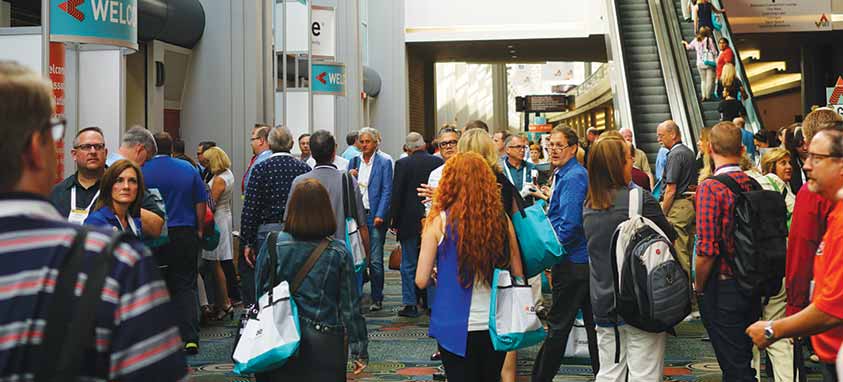2016 ASAE Annual Meeting & Exposition, Salt Lake City
ASAE takes new stand on discriminatory practices, adds tools and services
The American Society of Association Executives (ASAE) Annual Meeting & Exposition in Salt Lake City in August reinforced that the organization is in a period of enhanced activism that includes actively discouraging discriminatory practices.
Triggered partly by North Carolina’s House Bill 2—which prevents transgender people from using government-run bathrooms corresponding to the gender with which they identify—the ASAE board adopted a diversity and inclusion advocacy and policy model prior to the meeting that contains new contract language for future events.
“Our board feels that anyone who attends a meeting anywhere should be free of experiencing discriminatory practices,” said John Graham IV, CEO and president of ASAE. “We don’t take positions on political issues such as gun control and abortion, but intend to be more proactive about people needing to feel welcome when they go to any destination.”
The policy also is intended to protect ASAE from legislation that could threaten the success of planned meetings and conventions.
ASAE will proactively work with organizations, universities and groups to educate legislators about the consequences of discriminatory practices, including losing conventions and other association business.
Regarding the legislation passed in North Carolina, Graham said, “We probably would not hold a meeting in North Carolina.”
Graham acknowledges that sometimes, ASAE walks a “fine line” when trying to discourage discriminatory practices while respecting different cultural customs—especially in foreign countries.
He alluded to Saudi Arabia’s custom of having women cover their faces and walk behind men.
“That’s their culture, and we need to be respectful of other cultures,” he said.
New Program Options
ASAE also has been active in offering new program formats and tools to its members.
“Prior to 2008–09, we may have been getting better at executing, but we were doing the same things,” Graham said. “Since then, our industry has been trending more toward an engagement model, so ASAE has been emphasizing that more in things like modern technology.”
He points out that the new features represent a broadening of options rather than an elimination of those that traditionally have been available.
“We’re really not taking anything away from anyone,” he said. “We are adding to what we already had, to engage more of our members.”
Some of the new options implemented at the Salt Lake City meeting—held Aug. 13–16 at Calvin L. Rampton Salt Palace Convention Center—are particularly well-suited to millennials. They included 20-minute express learning sessions; story-slam gatherings, in which participants are given five minutes to share experiences with peers; ignite sessions, where presenters are allowed to use only 20 slides; and open space gatherings, which are spontaneously organized by participants who want to focus on a subject not included in the agenda.
“Some people now prefer these types of platforms, while others like longer sessions,” he said. “We want to include a number of different platforms.”
Traditional offerings, such as full-day certificate programs, half-day workshops and 90-minute educational sessions, were also available.
ASAE also introduced a new gamification app that enabled attendees to earn points and badges for visiting booths and participating in education sessions.
Handy Benchmarking Tool
Another new feature, AssociaMetrics, was launched in July by the ASAE Foundation, a separate, nonprofit entity that supports ASAE’s efforts. AssociaMetrics serves as an easy-to-use central access point for association benchmarking data. Members can generate custom data to see how they stack up against organizations of similar size, budget and tax status, among other parameters. One-year access includes compensation and benefits, as well as operating ratio data, plus any data sets added within the member’s access period.
The custom reports that are generated can be exported in Word, PDF or Excel, and can be used for:
–Informing decisions and strategy
–Supporting board presentations
–Identifying potential areas for improvement
–Pinpointing strong performance areas to build upon or showcase
–Negotiating salary increases
–Ensuring that personnel remuneration, structure and size are competitive
–Providing a more accurate overall picture of financial performance and financial position
Board Leadership Change
Another change at ASAE is the transition of Abe Eshkenazi to Scott Wiley as board chair. Eshkenazi is CEO of APICS, a professional association for supply chain management, while Wiley is president and CEO of the Ohio Society of CPAs. Both addressed the audience of some 4,000 people in Salt Lake City, and spoke afterward with Smart Meetings.
Eshkenazi emphasized that ASAE is an extremely successful organization with very capable leadership, but needs to keep evolving.
“The pace at which change is occurring is breathtaking, and it’s important that ASAE understands what its members need,” Eshkenazi said. “We have a lot more work to do to set the pace, rather than have it overtake us. Will we be the disrupted, or the disruptor? It’s important to take risks, to try new things.”
Wiley is looking forward to serving as board chair, and echoes Eshkenazi’s emphasis on change.
“It’s a very exciting time to be a part of the association profession and industry,” he says. “ASAE is really out front about not resting on its laurels, but we need to keep asking how we can demonstrate and deliver.”
He says that generally, ASAE’s role is to provide its more than 21,000 individual members—association professionals and industry partners—with exceptional content, career enhancement tools and a strong community.
“Nothing is more exciting than the energy in this community,” Wiley says. “Members have become better connected with each other, and are working together very well to navigate changes. ASAE’s creating its own level of disruption.”





